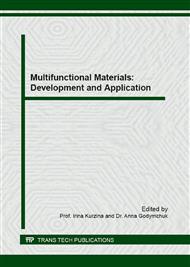[1]
K. Weman, Welding Processes Handbook, Elsevier, (2011).
Google Scholar
[2]
R.S. Mishra, Friction Stir Welding and Processing, ASM International, (2007).
Google Scholar
[3]
O. Sizova, A. Kolubaev, E. Kolubaev, A. Zaikina, V. Rubtsov, S. Psakhie, A. Chernyavsky, V. Lopota, The microstructure of aluminum-magnesium alloy friction Stir weld, AIP Conf. Proc. 1623 (2014) 587-590.
DOI: 10.1063/1.4899013
Google Scholar
[4]
S. Yu. Tarasov, V.E. Rubtsov, E.A. Kolubaev, A proposed diffusion-controlled wear mechanism of alloy steel friction stir welding (FSW) tools used on an aluminum alloy, Wear 318(1-2) (2014) 130-134.
DOI: 10.1016/j.wear.2014.06.014
Google Scholar
[5]
A.I. Dmitriev, W. Österle, H. Kloss, Numerical simulation of typical contact situations of brake friction materials, Tribol. Intern. 41(1) (2008) 1-8.
DOI: 10.1016/j.triboint.2007.04.001
Google Scholar
[6]
A.I. Dmitriev, A. Yu. Nikonov, S.G. Psakhie, Atomistic mechanism of grain boundary sliding with the example of a large-angle boundary Σ=5. Molecular dynamics calculation, Phys. mesomech. 14(1-2) (2011) 24-31.
DOI: 10.1016/j.physme.2011.04.004
Google Scholar
[7]
Iv.S. Konovalenko, D.S. Kryzhevich, K.P. Zol'nikov, S.G. Psakhie, Atomic mechanisms of local structural rearrangements in strained crystalline titanium grain, Tech. Phys. Let. 37(10) (2011) 946-948.
DOI: 10.1134/s1063785011100233
Google Scholar
[8]
S.G. Psakhie, K.P. Zol'nikov, A.I. Dmitriev, D.S. Kryzhevich, A.Y. Nikonov, Local structural transformations in the FCC lattice in various contact interaction. Molecular dynamics study, Phys. Mesomech. 15(3-4) (2012) 147-154.
DOI: 10.1134/s1029959912020026
Google Scholar
[9]
Information on http: /lammps. sandia. gov.
Google Scholar
[10]
A. Ostapovets, P. Molnar, P. Lejcek, Boundary plane distribution for Sigma 13 grain boundaries in magnesium, Mater. let. 137 (2014) 102-105.
DOI: 10.1016/j.matlet.2014.08.152
Google Scholar
[11]
C. Hu, M. Bai, J. Lv, H. Liu, X. Li, Molecular dynamics investigation of the effect of copper nanoparticle on the solid contact between friction surfaces, Appl. Surf. Sci. 321 (2014) 302-309.
DOI: 10.1016/j.apsusc.2014.10.006
Google Scholar
[12]
K. Xiong, X. Liu, J. Gu, Orientation-dependent crystal instability of gamma-TiAl in nanoindentation investigated by a multiscale interatomic potential finite-element model, Model. Simulat. Mater. Sci. Eng. 22 (2014) 085013.
DOI: 10.1088/0965-0393/22/8/085013
Google Scholar
[13]
B. Jelinek, S. Groh, M.F. Horstemeyer, J. Houze, S. G. Kim, G. J. Wagner, A. Moitra, M. I. Baskes, Modified embedded atom method potential for Al, Si, Mg, Cu, and Fe alloys, Phys. Rev. B. 85 (2012) 245102.
DOI: 10.1103/physrevb.85.245102
Google Scholar


